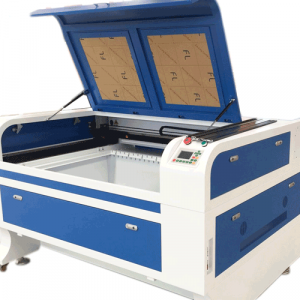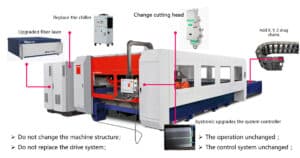The application of laser cutting of metal materials has been widely known, but many people do not know how to check the cutting quality when using laser cutting machines.
In fact, the cutting quality is usually judged from the angles of end face roughness, bottom burr, verticality, slit width, and so on.
Surface roughness
When laser-cutting material is affected by airflow and feed speed, the end face will form a vertical (or inclined) grain. The deeper the grain, the rougher the end face, and the shallower the grain, the smoother the end face.
The roughness affects not only the appearance of the edge but also the friction characteristics, so the lower the roughness, the higher the cutting quality.
Adjusting parameters such as laser power, feed speed, focal length, type of auxiliary gas, and air pressure can continuously optimize the end surface roughness.
Bottom burr
The principle of laser cutting metal is that the metal is vaporized instantly by the high energy of the laser, and the molten slag on the workpiece surface is blown away by auxiliary gas.
However, in the actual processing process, the thickness of the plate, insufficient air pressure, feed speed mismatch, and other factors will cause part of the slag to form a burr after cooling, hanging at the bottom of the workpiece.
At this time, extra deburring work is needed, and additional man-hours are consumed. The burr and hanging slag at the bottom of the workpiece are essential criteria for judging the cutting quality.
Verticality
For thin metal plates, the verticality of laser cutting is negligible, but when the thickness of the material exceeds 10mm, the verticality of the cutting edge is very important.
When away from the focus, the laser beam diverges, and the cut widens toward the top or bottom, depending on the position of the focus.
The cutting edge deviates from the vertical line by a few millimeters, and the more vertical the edge, the higher the cutting quality.
Cutting width
The cutting width is the embodiment of the machining accuracy, which usually does not affect the cutting quality. Only when the internal profile and pattern of the workpiece need to be formed the slit width will become an important index.
The cutting width determines the minimum inner diameter of the contour. The smaller the slit width is, the more precise the profile, and the smaller the hole diameter is, which is one of the important advantages of laser cutting instead of plasma cutting.
However, with the increase in plate thickness, the slit width will inevitably increase. In order to ensure stable and high-precision cutting, it is necessary to ensure that the workpiece is stable in the processing area of the laser cutting machine.







